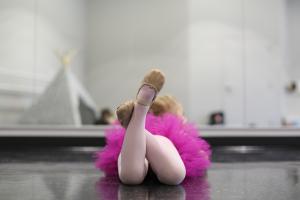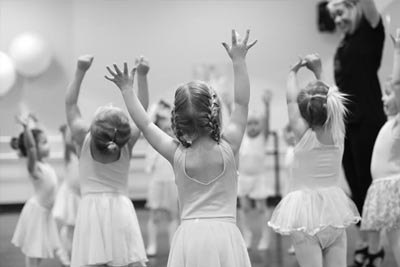Scientific Benefits of Preschool Dance
When your child is little, there’s no shortage of activities to choose from, and it can be overwhelming to decide what to enroll them in. Once you try to figure out what they are interested in and what is close to you with available classes, the next question you have is “how much do they really get out of it at this age?”
When it comes to preschool dance classes, the answer is: a lot.
Dance has been studied relentlessly by the top scientific universities in the world, and the results are staggeringly positive. Numerous benefits of dance are obvious to any observer, but we don’t often think about the incredible developmental benefits that come from dance when it is introduced at a young age.

Lets Kids Learn Their Way
As adults, it can drive us crazy when those little kids just won’t sit still, but truthfully, their most effective learning is through physical and sensory experiences. In dance class, we foster that need for movement in a myriad of ways and maximize our sensory experience through musical connection. Rather than trying to get them to sit still while learning their counting, their directions, and the names of their different body parts, they will jump, crawl, wiggle, twirl, and giggle while they learn. These crucial aspects of early learning are made into tangible concepts that put our little dancers ahead in their academic endeavours without compromising their fun.
Develops the Muscles Necessary for Writing
Obviously, movements for our preschool classes are mostly based around fun, but there are underlying benefits that come along with them.
You may watch your little dancer crawl around and pretend to be a puppy, do a bear crawl, or any other number of crawl-like actions. When it comes to our dance education, these actions help dancers to move in different ways, learn levels of movement, and act as a foundation for other dance skills—but they also have far-reaching effects in a dancer’s overall development.
The way that we move our hands and our wrists while bearing our weight in a crawl causes both the larger and smaller muscles in our wrists and shoulders to be stimulated and strengthened. Different types of crawls also change the way that a dancer’s eyes track across the room, which boosts their ability to track the letters on a page when reading.
In short, these silly little exercises help prepare children for the movements required in writing, drawing, and other fine motor movements needed academically and beyond.
Promotion of Social and Emotional Skills
A major focus in our preschoolers’ development is rooted in emotional regulation and learning how to get along with others, and dance can accelerate the progress in these areas.
Studies have shown that dancing with others promotes co-regulation and stronger social bonds than other observed activities. All sorts of lovely hormones are released while dancing in a group that make your child feel safe, accepted, and joyful. In this co-regulated state, our little dancers’ brains are open to learning, making friends, and noticing the world around them.
Accelerates Brain Development
One of those things that everybody knows about dance is that it drastically improves your coordination and spatial awareness, but did you know that it also accelerates the brain development in young dancers?
Musical training, like dance, fortifies neural connections more rapidly to the point that research shows young children with musical training develop speech and language comprehension sooner than their peers.
Dance also uses many cross-lateral movements— that is, movements that cross the middle of your body to the other side or use both sides of the body at once—which force our brain to strengthen the connections between one brain hemisphere to the other. These pathways have been shown to create greater spatial awareness and problem-solving skills.
Register Today!
We know it takes time to research and find out what the best fit for your family will be when it comes to your extra-curricular activities, so below we’ve attached some research to help you on your journey. And if you decide dance and all its amazing benefits are for your family, there’s no need to wait to register! Prestige Dance Academy’s registration is open throughout the season for our 10-month, 6-month, and 8-week programs.
Here’s to happy, active kids who thrive.
Reference Links
1. Theodotou, E. (2025). Dancing With children or dancing for children? Measuring the effects of a dance intervention in children’s confidence and agency. Early Child Development and Care, 1–10. https://www.tandfonline.com/doi/full/10.1080/03004430.2025.2452587?mi=5t0s03#d1e344
2. Sheppard A, Broughton MC. Promoting wellbeing and health through active participation in music and dance: a systematic review. Int J Qual Stud Health Well-being. 2020 Dec;15(1):1732526. doi: 10.1080/17482631.2020.1732526. PMID: 32267216; PMCID: PMC7178871.
https://pmc.ncbi.nlm.nih.gov/articles/PMC7178871/
3. Gersema, Emily (2016). Children’s brains develop faster with music training
https://today.usc.edu/childrens-brains-develop-faster-with-music-training/
4. UPMC Neurosurgery (2014). How Music Affects a Child’s Brain
https://share.upmc.com/2014/12/how-music-affects-a-childs-brain/
5. Trinh Nguyen, Erica Flaten, Laurel J. Trainor, Giacomo Novembre,
Early social communication through music: State of the art and future perspectives,
Developmental Cognitive Neuroscience,
Volume 63, 2023, 101279,ISSN 1878-9293
https://www.sciencedirect.com/science/article/pii/S1878929323000841
6. Bégel V, Bachrach A, Dalla Bella S, Laroche J, Clément S, Riquet A, Dellacherie D. Dance Improves Motor, Cognitive, and Social Skills in Children With Developmental Cerebellar Anomalies. Cerebellum. 2022 Apr;21(2):264-279. Doi: 10.1007/s12311-021-01291-2. Epub 2021 Jun 24. PMID: 34169400.
https://pubmed.ncbi.nlm.nih.gov/34169400/
7. Magrieta Maria VisserI; Denise FranzsenII
IMSc Occupational Therapy (Wits); Lecturer, Department of Occupational Therapy, Faculty of Health Sciences University of the Free State
IIMSc Occupational Therapy (Wits); Lecturer, Department of Occupational Therapy, Faculty of Health Sciences, University of the Witwatersrand
https://www.scielo.org.za/scielo.php?script=sci_arttext&pid=S2310-38332010000200006

